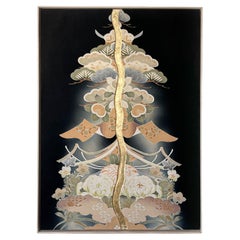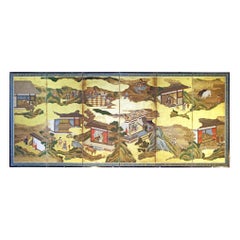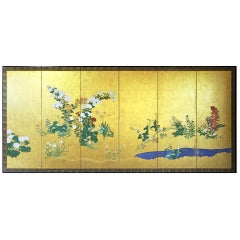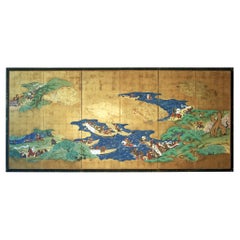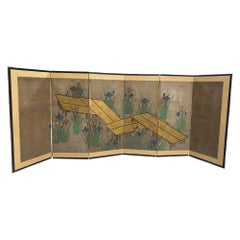Gold Leaf Paintings and Screens
to
8
121
40
221
10
2
1
60
101
60
12
15
10
5
2
1
2
2
3
1
1
6,950
785
748
724
544
213
204
189
14
14
233
227
231
9
2
1
1
1
Material: Gold Leaf
Meiji Era, Circa 1900 Japanese Screen Pair, Flowers & Birds of Spring & Autumn
Located in Kyoto, JP
Flowers & Birds of Spring and Autumn
Unknown artist.
Japan. Meiji period, circa 1900.
A pair of six-fold screens. Ink, color, gofun and gold leaf on paper.
Signed: Gaga S...
Category
1890s Japanese Meiji Antique Gold Leaf Paintings and Screens
Materials
Gold Leaf
Antique kimono textile art "Prosperity Tree" by ikasu Black, Japan
By Kimono ikasu
Located in Setagaya City, JP
This work uses an antique kimono fabric dated Taisho era (early 1910th), with a pine tree motif, and arranges it so that it looks like a tree decorated with various auspicious symbols - persimmons, pines, peonies, etc.
The line in the middle symbolizes “kintsugi” - concept of wabi-sabi, which values imperfection, impermanence, and the beauty of aging.
It is elegantly framed with paulownia wood originally used for kimono chest-of-drawers, and is filled with storytelling and sense of luxury.
I used pieces of kimono that could no longer be used as clothing and kiritansu chest-of-drawers that would normally be discarded to create the ultimate upcycled piece.
<< Explanation and meaning of pattern and colors >>
The art work features the matsu - pine pattern, which depicts the Japanese pine tree spreading over deep black fabric. It appears as if the pine dranches are decorated with various auspicious symbols - persimmons, pines, peonies, etc.
In East Asia, the pine tree is revered as a symbol of longevity due to its vibrant green leaves, even during the winter season.
In Japan, it's often referred to as the "evergreen tree" because its leaves remain green throughout the year, making it a symbol of good fortune that has been cherished for a long time.
<< Characteristics of the fabric >>
The fabric is hand-painted in traditional Japanese technique "yuzen".
<< About the frame >>
Kiritansu - chest-of-drawers for kimono, is traditionally made from paulownia wood, a uniquely Japanese material closely tied to the world of kimonos.
Paulownia wood is known as the lightest wood in Japan, prased for its natural luster, resistance to moisture, and resilience against cracking. Since ancient times, it has been used in crafting furniture, chests, and musical instruments.
During the Edo period, it became customary to store cherished kimonos in paulownia chests...
Category
Early 20th Century Japanese Japonisme Gold Leaf Paintings and Screens
Materials
Gold Leaf
Japanese Tosa School Framed Six Panel Screen Gold Leaf
Located in Brescia, IT
Japanese six-panel screen of the famous "Tosa school" made by an anonymous artist of the mid-18th century, work painted in the classic way with colored pigments and inks on vegetable...
Category
Mid-18th Century Japanese Edo Antique Gold Leaf Paintings and Screens
Materials
Gold Leaf
Edo Landscape Japanese Folding Screen
Located in Brescia, IT
Refined work by a painter from the first half of the 19th century, from the landscape of the "Rinpa" school by a painter from the end of the 18th century, the Rinpa school.
Six panels painted in ink on gold leaf and "gofun" on vegetable paper.
The flowers are made with the "gofun" technique, natural or pigmented white oyster powder.
Rinpa is one of the major historical schools of Japanese painting. The style was consolidated by the brothers Ogata Korin (1658–1716) and Ogata Kenzan (1663–1743).
This folding screen has a very clean design that leaves plenty of room for the beautiful golden landscape.
It comes flat and you can easily hang it with our hooks.
Lucio Morini...
Category
18th Century Japanese Edo Antique Gold Leaf Paintings and Screens
Materials
Gold Leaf
Edo 19th Century Japanese Folding Screen Six Panels Battle of Menpei
Located in Brescia, IT
Samurai on horseback and by boat from the famous battle of Menpei Japanese folding screen six-panel of "Tosa School" painted with mineral pigments on vegetable on golden silk , earl...
Category
Early 19th Century Japanese Edo Antique Gold Leaf Paintings and Screens
Materials
Gold Leaf
Japanese Asian Six-Panel Folding Byobu Screen Landcape Bridge with Iris Flowers
Located in Studio City, CA
A gorgeous six-panel Japanese Byobu folding screen depicting a nature lake/landscape scene with a water walkway/angular bridge and blossoming iris flowers - perhaps an homage to the famed Irises screens...
Category
19th Century Japanese Edo Antique Gold Leaf Paintings and Screens
Materials
Gold Leaf
Pair of Japanese Edo Six Panel Screens the Seven Sages
Located in Rio Vista, CA
Fantastic pair of 19th century Japanese late Edo/early Meiji period six-panel screens titled The seven sages of the bamboo grove. The Kano school screens...
Category
19th Century Japanese Edo Antique Gold Leaf Paintings and Screens
Materials
Brass, Gold Leaf
Japanese Byobu - Japanese Folding Screen Gold Leaf
Located in Brescia, IT
Floral scene of a "Rimpa School" garden with polychrome chrysanthemum flowers.
Six-panel screen painted with pigments on golden rice paper of good size and well preserved.
Bold color...
Category
Early 19th Century Japanese Edo Antique Gold Leaf Paintings and Screens
Materials
Gold Leaf
Japanese Screen, Early 20th Century Wagtail & Chrysanthemum by Ishizaki Koyo
Located in Kyoto, JP
Ishizaki Koyo (1884-1947)
Wagtail & Chrysanthemum
Early 20th century
Folding screen in two-panels. Ink, pigments and gofun on gold leaf.
Sign: Koyo
Seal: Koyo
This ...
Category
Early 20th Century Japanese Taisho Gold Leaf Paintings and Screens
Materials
Gold Leaf
Japanese Edo Four Panel Screen Kano School Filial Piety
Located in Rio Vista, CA
Early 19th century late Edo period Japanese four-panel screen depicting examples from the 24 paragons of filial piety. Painted in the Kano School style featuring figures in colorful,...
Category
19th Century Japanese Edo Antique Gold Leaf Paintings and Screens
Materials
Brass, Gold Leaf
Superb Japanese Landscape Scroll with Sakura and Bamboo, 16th–17th Century
Located in Fukuoka, JP
A refined and poetic Japanese landscape painting dating from the late Muromachi to early Edo period (16th–17th century). Executed in mineral pigments on paper, the composition captur...
Category
Early 17th Century Asian Edo Antique Gold Leaf Paintings and Screens
Materials
Gold Leaf
17th Century Japanese Screen. Karako Asobi: Chinese Children at Play.
Located in Kyoto, JP
Anonymous Kano school artist
17th century
"Karako Asobi: Chinese Children at Play"
A two-panel Japanese Furosaki screen. Ink, pigment, gofun and gold-leaf on paper.
This small Japanese Karako folding screen vividly depicts various games played by children wearing wearing elaborate Chinese T'ang dynasty costumes. They are dressed in plumed and tasseled hats, ornate jackets, baggy pants, and cloth slippers typical of T'ang period Chinese court dress. The children are depicted pulling a younger child along in a cart, carrying another child as if an important official, riding a wooden horse, leading a puppy and carrying a tethered bird. Executed in fine-quality pigments on gold leaf, the detail, variety and size of the figures is noteworthy. Also notable is the size of this screen itself, which denotes it as a Furosaki screen. A Furosaki screen is part of the equipment used for the Japanese tea-ceremony. It is traditionally placed on tatami mats behind the brazier highlighting the utensils and providing a focal point.
Karako is a Japanese term used in art with the depiction of Chinese children playing...
Category
17th Century Edo Antique Gold Leaf Paintings and Screens
Materials
Gold Leaf
18th Century Japanese Floral Paintings, Set of 5, Mineral Pigments on Gold Leaf
Located in Kyoto, JP
A set of 5 Japanese floral paintings from the 18th century. Each painted with mineral pigments directly applied to gold leaf. They were originally designed to be mounted on the leave...
Category
Mid-18th Century Japanese Edo Antique Gold Leaf Paintings and Screens
Materials
Gold Leaf
19th Century Japanese Screen, Deer in Spring, Maruyama Shijo School
Located in Kyoto, JP
A six-panel Japanese folding screen from the leading Maruyama-Shijo artist Okamoto Toyohiko (1773-1845). Simply featuring three deer and a few sprigs of foliage on a sumptuous gold-leaf background this work emphasizes naturalistic expression and a masterful use of negative space. Reduced to its most basic elements, the blank spaces inspire imagination and evoke the smells, sounds and even the weather of the scene. Whilst deer are traditionally depicted in association with autumn, here the green growth on the tops of the foliage indicates the season of spring. The work references Maruyama Okyo’s two-panel deer screen...
Category
Early 19th Century Japanese Edo Antique Gold Leaf Paintings and Screens
Materials
Gold Leaf
Paravento Due Pannelli Bambù su Foglia d'Oro
Located in Brescia, IT
Paesaggio giapponese della sciuola di Kano dei primi anni del XVIII° secolo a due pannelli con alberi di bambù. Pigmenti minerali e foglia d'oro su carta vegetale. Bordo in seta ne b...
Category
Early 18th Century Japanese Edo Antique Gold Leaf Paintings and Screens
Materials
Gold Leaf
Japanese Meiji Six Panel Screen Brushwood Gate with Chrysanthemums
Located in Rio Vista, CA
Gorgeous Japanese early 20th century Meiji period six-panel byobu screen featuring a brushwood gate and fence with flowering chrysanthemums. The large screen is crafted with ink and ...
Category
20th Century Japanese Meiji Gold Leaf Paintings and Screens
Materials
Brass, Gold Leaf, Silver Leaf
Japanese Edo Two Panel Screen Deities by Yokoyama Kazan
Located in Rio Vista, CA
Whimsical Japanese late Edo period two-panel screen circa 1800 by Yokoyama Kazan (Japanese 1784-1837). The screen depicts four of the seven Gods or deities ...
Category
19th Century Japanese Edo Antique Gold Leaf Paintings and Screens
Materials
Brass, Gold Leaf
20th Century Chinese Gilt Coromandel Eight-Panel Screen Immortals Sky Gods
Located in Rio Vista, CA
Amazing Chinese export eight-panel lacquered coromandel screen depicting a heavenly scene of immortals and sky gods floating in ruyi clouds. The fascin...
Category
20th Century Chinese Chinese Export Gold Leaf Paintings and Screens
Materials
Brass, Gold Leaf
19th Century Japanese Screen for Tea-Ceremony, Ink Bamboo and Plum on Gold Leaf
Located in Kyoto, JP
Three Friends of Winter
Nakajima Raisho (1796-1871)
Late Edo period, circa 1850
Ink and gold leaf on paper.
This is a double-sided Japanese Furosaki or tea-ceremony screen from the mid 19th century; bamboo and plum on the front, young pines the back. It by Nakajima Raisho, a master painter of the Maruyama school in the late Edo and early Meiji periods. In this work Raisho combines exquisite ink brushwork with large open spaces of brilliant gold-leaf to inspire the viewers imagination. Rather than naturalism, he is searching for the phycological impression of the motifs, resulting in abstraction and stylization. His simplification of the motifs the result of looking to capture the inner nature of the objects. This art motif is known as Sho Chiku Bai, or the Three Friends of Winter. Evergreen pine connotes steadfastness, bamboo suggests both strength and flexibility, while plum blossoms unfurling on snow-laden branches imply hardiness. Combined, this trio is emblematic of Japanese new year. Chinese literati were the first to group the three plants together due to their noble characteristics. Like these resilient plants flowering so beautifully in winter, it was expected of the scholar-gentleman to cultivate a strong character with which he would be able to show the same degree of perseverance and steadfastness even during times of adverse conditions.
The screen would have been placed near the hearth of a room used for the Japanese tea ceremony, shielding the fire from draughts and also forming a stimulating and decorative backdrop behind the tea utensils. It would have been used in the Hatsugama, or first tea-ceremony of the new year.
Nakajima Raisho (1796-1871) originally studied under Watanabe Nangaku before entering the school of Maruyama Ozui. He was the highest ranking Maruyama school painter at the end of the Edo period and was known as one of the ‘Four Heian Families’ along with Kishi...
Category
Mid-19th Century Japanese Edo Antique Gold Leaf Paintings and Screens
Materials
Gold Leaf
Japanese Edo Six Panel Screen Merrymaking in the Chinese Countryside
Located in Rio Vista, CA
Large 19th century Japanese Edo period six panel folding byobu screen made in the Kano school style. Beautifully crafted with signature after Kano Tan'yu. Ink and natural color pigme...
Category
19th Century Japanese Edo Antique Gold Leaf Paintings and Screens
Materials
Gold Leaf
Byôbu Screen 屏風 Chrysanthemums, Rinpa School, Edo / Meiji period
By Rinpu Sasaki
Located in Valladolid, ES
One of a kind and very refined Japanese screen or byôbu 屏風 with six folding panels depicting chrysanthemums on a gold background. Fine lacquered wooden frame with metal fittings that protects and supports the work. Dating from the 19th century, between the late Edo period (1603-1868) and the early Meiji period (1868-1912),
The main motif of this beautiful byôbu is a serene Rinpa School painting on a gold background depicting a peaceful flower garden filled with white chrysanthemums. The painting reflects the gentle elegance characteristic of the Rinpa school, known for its refined depiction of nature. In Japanese culture, chrysanthemums symbolize happiness, love, longevity and joy.
Rinpa or Rimpa is the name of one of the most important schools of Japanese painting. It emerged in the 17th century with the artists Honami Kōetsu...
Category
1880s Japanese Edo Antique Gold Leaf Paintings and Screens
Materials
Gold Leaf, Silver Leaf
Japanese Screen Pair, Tigers by Kishi Renzan, Late Edo Period
Located in Kyoto, JP
Kishi Renzan (1804-1859)
Tigers
Pair of six-panel Japanese screens.
Ink and gold-leaf on paper.
In this monochromatic pair of six-fold Japanese screens painted on gold-leaf, Kishi Renzan has created a breathtaking composition of a family of tigers. The screens are filled with a sense of drama which is conveyed by both the subject matter and the wet, expressive brushwork. The running mountain stream and the towering waterfall allude to refreshment during the summer months and we feel the tiger families familiarity and security within their environment. Renzan’s master, Kishi Ganku...
Category
Mid-19th Century Asian Edo Antique Gold Leaf Paintings and Screens
Materials
Gold Leaf
Gold Leafed Screen - Late Meiji Period
Located in Fukuoka, JP
Gold Leafed Screen - Late Edo to Meiji Transition
Period: Mid-19th century (Late Edo - Meiji)
Size: 384 x 169 cm
SKU: PN32
Hailing from a pivotal era in Japanese history, this gold...
Category
Early 20th Century Japanese Edo Gold Leaf Paintings and Screens
Materials
Gold Leaf
Antique Japanese Four Panel Byobu Screen: Mandarin Ducks by Snowy Pond in Early
Located in Sheridan, CO
Antique Japanese Four Panel Byobu Screen: Mandarin Ducks by Snowy Pond in Early Spring.
Kano School painting of a weeping willow tree with branches over a stunning indigo blue pond. ...
Category
Early 20th Century Meiji Gold Leaf Paintings and Screens
Materials
Metal, Gold Leaf
Japanese Two Panel Screen: Iris By Rivers Edge
Located in Hudson, NY
Mineral pigments and gold leaf on mulberry paper with black lacquer trim.
Category
Early 19th Century Japanese Antique Gold Leaf Paintings and Screens
Materials
Gold Leaf
Japanese Screen Painting, Circa 1700 'Tales of Ise' by Tosa Mitsusuke
By Tosa Mitsusuke 1
Located in Kyoto, JP
A six-fold Japanese screen by Tosa Mitsusuke (1675-1710), Japan 17th-18th century, Edo period.
The signature reads Shoroku-i ge Tosa sa Konoe Shogen Mit...
Category
Late 17th Century Japanese Edo Antique Gold Leaf Paintings and Screens
Materials
Gold Leaf
Pair of Japanese Edo Rimpa School Screens after Tawaraya Sotatsu
Located in Rio Vista, CA
Impressive pair of 17th century Japanese Edo period Rinpa school screens made in the manner and style of Autumn Grasses by Tawaraya Sotatsu (1570-1640). Beautifully decorated with wi...
Category
17th Century Japanese Edo Antique Gold Leaf Paintings and Screens
Materials
Gold Leaf
18th Century Five-Panel Chinese Coromandel Screel
Located in CABA, AR
Transport yourself back to the opulent splendor of the 18th century with this magnificent Chinese five-panel black Coromandel screen, a true m...
Category
18th Century Chinese Chinese Export Antique Gold Leaf Paintings and Screens
Materials
Gold Leaf
Persian Manuscript Page - Garden Scene
Located in Soquel, CA
Persian Manuscript Page depicting a garden scene. Circa 18th century.
Hand painted scene depicts a hilly outdoor landscape where people are congre...
Category
Late 18th Century Persian Islamic Antique Gold Leaf Paintings and Screens
Materials
Gold Leaf
Meiji Era Japanese Two Panel Hand Painted Wood Table Screen Tale of Genji
Located in Studio City, CA
A Meiji era Japanese two-panel wood screen, with illustrated images from The Tale of Genji that are exquisitely painted directly on wood with fine detail and precision, accented with scattered 24k gold leaf specks in cloud forms, rendered in the manner of Heian period...
Category
19th Century Japanese Meiji Antique Gold Leaf Paintings and Screens
Materials
Gold Leaf
Japanese Six-Panel Screen, a Garden for All Seasons
Located in Hudson, NY
An imaginary garden with flowers from all seasons including spring lilies, summer hibiscuses, autumn chrysanthemums, and winter berries. Wild autumn grasses move in a soft breeze wit...
Category
1890s Japanese Meiji Antique Gold Leaf Paintings and Screens
Materials
Gold Leaf
Edo Tiger Screens by Tosa Mitsusada
By Tosa School
Located in Fukuoka, JP
Edo Tiger Screens by Tosa Mitsusada
Period: Edo
Size: 358x175.5 cm
SKU: PTA119
Enter the captivating world of Japanese artistry with our pair of painted...
Category
18th Century Japanese Edo Antique Gold Leaf Paintings and Screens
Materials
Gold Leaf
Pair of Antique Japanese Paintings of Karashishi, Edo Period, 18th Century
Located in Prahran, Victoria
A rare pair of antique Japanese Karashishi paintings in a landscape of rocks and peony flowers on gold leaf ground in fine handmade frames, Edo period, early 18th century. The Karash...
Category
Early 18th Century Japanese Edo Antique Gold Leaf Paintings and Screens
Materials
Gold Leaf
Japanese Asian Large Six-Panel Folding Byobu Flower Cart Screen, 19th Century
Located in Studio City, CA
A gorgeous six-panel Japanese Byobu folding screen. Listing as Meiji period but could very possibly Edo period. Decorated with peonies, irises and...
Category
19th Century Japanese Meiji Antique Gold Leaf Paintings and Screens
Materials
Gold Leaf
Late 17th Century Japanese Screen. Puppy and Kittens on Gold Leaf.
Located in Kyoto, JP
Anonymous
Late 17th century
Puppy & Kittens
A six-panel Japanese screen. Ink, color, gofun, gold-leaf and gold-fleck on paper.
A medium sized late 17th century Japanese screen fe...
Category
Late 17th Century Japanese Edo Antique Gold Leaf Paintings and Screens
Materials
Gold Leaf
Japanese Two-Panel Screen "Leopard with Cubs"
Located in Hudson, NY
With gold clouds on gold leaf with camellia on river's edge.
In history, Japanese artists did not see leopards or tigers in real life because the animals were not native to Japan, t...
Category
Mid-19th Century Japanese Antique Gold Leaf Paintings and Screens
Materials
Gold Leaf
Painted canvas representing birds in the savannah. Contemporary.
Located in Saint-Ouen, FR
Painted canvas representing orange-colored birds in the savannah, with large leaves in the foreground and bushes in the background. Wands made from copper foil.
Work of contemporary...
Category
20th Century French Gold Leaf Paintings and Screens
Materials
Gold Leaf
Showa Golden Mallow Screen
Located in Fukuoka, JP
This exquisite two-panel screen from the Showa period features a lush depiction of mallows in vibrant hues set against a luxurious golden background. The mallow flower, known in Japa...
Category
20th Century Japanese Showa Gold Leaf Paintings and Screens
Materials
Gold Leaf
Elegant Horse Screen. In style of Kano Tanshin
By Kano Tanshin
Located in Fukuoka, JP
Ink on gold.
This continuation of equine grace unfolds across a stunning gold-leaf backdrop, capturing the essence of nobility that horses represent in Japanese lore.
The screen de...
Category
Late 18th Century Japanese Edo Antique Gold Leaf Paintings and Screens
Materials
Gold Leaf
Tibetan Thangka of Celebration Hand Painted Gilded
Located in Somis, CA
An exquisite hand painted Tibetan Thangka depicting 63 Buddhas with consorts and 5 protector Vajrabhairavas. Buddha seated dhyana asana on lotus throne at the center of the mandala i...
Category
2010s Nepalese Gold Leaf Paintings and Screens
Materials
Gold Leaf
Japanese Six Panel Screen Scattered Fans
Located in Hudson, NY
Striking painting depicting scattered fans painted on gold leaf. Featuring various scenes from classic Japanese literature, flowers and birds. Mineral pigmen...
Category
Mid-18th Century Japanese Antique Gold Leaf Paintings and Screens
Materials
Gold Leaf
Late 19th century (Meiji period) painting depicting tiger
Located in Fukuoka, JP
Antique Tiger Painting on Paper – Meiji Period
A striking depiction of a tiger, painted on paper and signed by the artist. This work was originally part of a Japanese byobu folding ...
Category
Late 19th Century Japanese Meiji Antique Gold Leaf Paintings and Screens
Materials
Gold Leaf
Japanese Two Panel Screen: Painted Fans on Gold Leaf
Located in Hudson, NY
Mineral pigments on gold leaf with brocade border. Calligraphy and sketching on back paper.
Category
Late 19th Century Japanese Antique Gold Leaf Paintings and Screens
Materials
Gold Leaf
Showa Delicate Floral Screen
Located in Fukuoka, JP
This graceful two-panel screen captures the essence of summer with its subtle depiction of slender grasses and fine lines, artfully arranged against a golden background. The screen e...
Category
20th Century Japanese Showa Gold Leaf Paintings and Screens
Materials
Gold Leaf
Japanese Six-Panel Screen, Winter Landscape with Flowering Plum
Located in Hudson, NY
Japanese six-panel screen: Winter landscape with flowering plum, Meiji period (1868-1912) painting of a full moon with wild grasses between river's edge and a snow covered plum tree ...
Category
Early 20th Century Japanese Meiji Gold Leaf Paintings and Screens
Materials
Gold Leaf
Japanese Six-Panel Screen Byobu With Chrysanthemums And Autumn Grass and Flower
Located in Torino, IT
The 19th Century Six-Panel Japanese folding screen "Byōbu" usually used in the most important Japanese house to stop wind and also to separate different space of the same big room de...
Category
Mid-19th Century Japanese Edo Antique Gold Leaf Paintings and Screens
Materials
Gold Leaf
19th Century Japanese Edo Screen Kano School Garden Terrace
Located in Rio Vista, CA
Fantastic 19th century Japanese Edo/Tokugawa period two-panel byobu screen featuring Chinese children frolicking on a garden terrace with a pavilion and large pine tree. Made in the ...
Category
19th Century Japanese Edo Antique Gold Leaf Paintings and Screens
Materials
Brass, Gold Leaf
Late 19th century (Meiji period) painting depicting tiger
Located in Fukuoka, JP
Antique Tiger Painting on Paper – Meiji Period
A striking depiction of a tiger, painted on paper and signed by the artist. This work was originally part of a Japanese byobu folding ...
Category
Late 19th Century Japanese Meiji Antique Gold Leaf Paintings and Screens
Materials
Gold Leaf
Japanese Six-Panel Screen Winter Into Spring
Located in Hudson, NY
With snow-covered willow tree, garden stone and winter berries. Right panels have spring flowers and a view of hills in the distance (likely the Higashiyama Hills painted in Kyoto by...
Category
18th Century Japanese Edo Antique Gold Leaf Paintings and Screens
Materials
Gold Leaf
Japanese Six-Panel Screen, Rimpa School Chrysanthemums on Gold
Located in Hudson, NY
An abundant use of gold with beautifully draped chrysanthemums and gold flake clouds. Mineral pigments, go fun, gold leaf on mulberry paper with a silk brocade border.
Category
Early 19th Century Japanese Meiji Antique Gold Leaf Paintings and Screens
Materials
Gold Leaf
Pair of Japanese Six Panel Screens: Floral Landscape / Mother with Young
Located in Hudson, NY
The first screen is depicting a mother watching her young frolicking under pine tree by river's edge, the second, a mother and her young playing under a ...
Category
Late 18th Century Japanese Antique Gold Leaf Paintings and Screens
Materials
Gold Leaf
Paravento Giapponese a sei pannelli su foglia d'oro.
Located in Brescia, IT
Paravento giapponese a sei pannelli , opera di un pittore della prima metà del 19° secolo, di scuola Rinpa.
Sei pannelli dipinti con inchiostro su foglia oro e "gofun" su carta veget...
Category
Early 19th Century Japanese Edo Antique Gold Leaf Paintings and Screens
Materials
Gold Leaf
Romantic Edo Peacock Screen
Located in Fukuoka, JP
Romantic Edo Peacock Screen
Period: Edo
Size: 379x173 cm
SKU: PTA144
Step into a world of romance with our beautiful six-panel Edo screen adorned with golden leaves. This masterpie...
Category
18th Century Japanese Edo Antique Gold Leaf Paintings and Screens
Materials
Gold Leaf
Pair of Japanese Edo/Tokugawa Screens Tale of Heiki
Located in Rio Vista, CA
Monumental pair of late 18th century Japanese Edo/Tokugawa period byobu screens depicting the battles between Taira and Minamoto. The screens have six panels each with individual sce...
Category
19th Century Japanese Edo Antique Gold Leaf Paintings and Screens
Materials
Brass, Gold Leaf
Japanese Edo Six Panel Screen Chinese Children at Play
Located in Rio Vista, CA
Amazing 19th century Japanese Edo period six panel folding byobu screen depicting Chinese children at play. The screen alludes to the 100 children theme. ...
Category
19th Century Japanese Edo Antique Gold Leaf Paintings and Screens
Materials
Gold Leaf
Japanese Six-Panel Screen, Chrysanthemums
Located in Hudson, NY
Japanese six-panel screen: Chrysanthemums, Edo period (circa 1800) painting of a variety of chrysanthemums in a garden landscape, with sparrows. Mineral p...
Category
Early 1800s Japanese Edo Antique Gold Leaf Paintings and Screens
Materials
Gold Leaf
Japanese Two-Panel Screen: Cranes on Gold
Located in Hudson, NY
Early Kano School painting of pine trees overlooking two beautifully painted cranes and floral design in a natural setting by water’s edge. Mineral pig...
Category
Late 18th Century Japanese Antique Gold Leaf Paintings and Screens
Materials
Gold, Gold Leaf
Japanese Asian Signed Six-Panel Folding Byobu Screen of Playful Court Scene
Located in Studio City, CA
A gorgeous, quite fascinating hand-painted six-panel Japanese Byobu folding screen depicting a rather engaging androgynous or erotic court scene (it has been suggested to us that thi...
Category
Mid-20th Century Japanese Showa Gold Leaf Paintings and Screens
Materials
Gold Leaf
Recently Viewed
View AllMore Ways To Browse
Huang Gang
Ikuo Hirayama
18th Century Coromandel Screen Large Chinese
Antique Erotic Miniature Paintings
Asian 4 Wall Panel Gold Birds And Flowers
Asian Painting On Silk 1980s
Autumn Grasses Japanese Six Fold Screen
Battle Of Yashima
20th Century Showa Period Garden Folding
Asian 4 Panel Floor Screens
Zhao Shao Ang
19th Century Japanese Poem Calligraphy Hanging Scroll
Yamaguchi Sekkei

